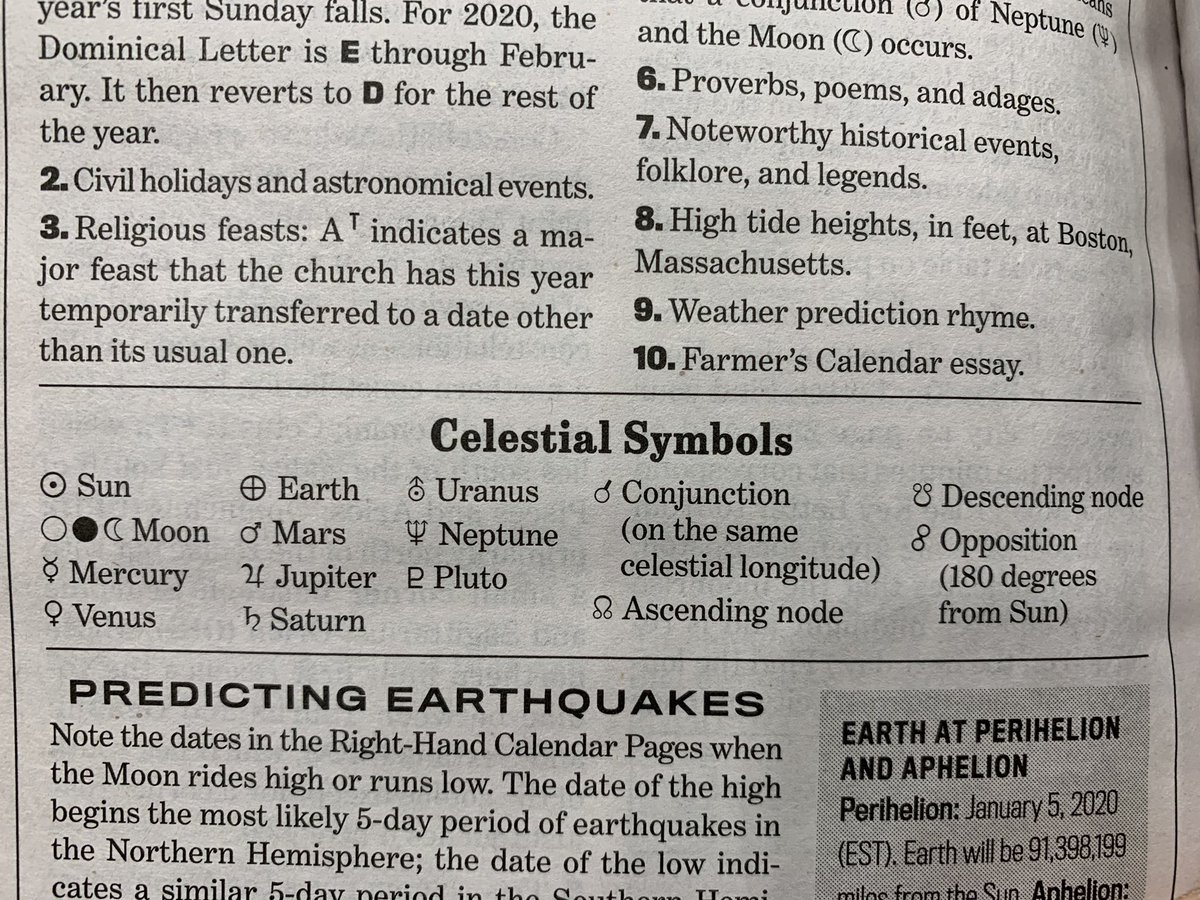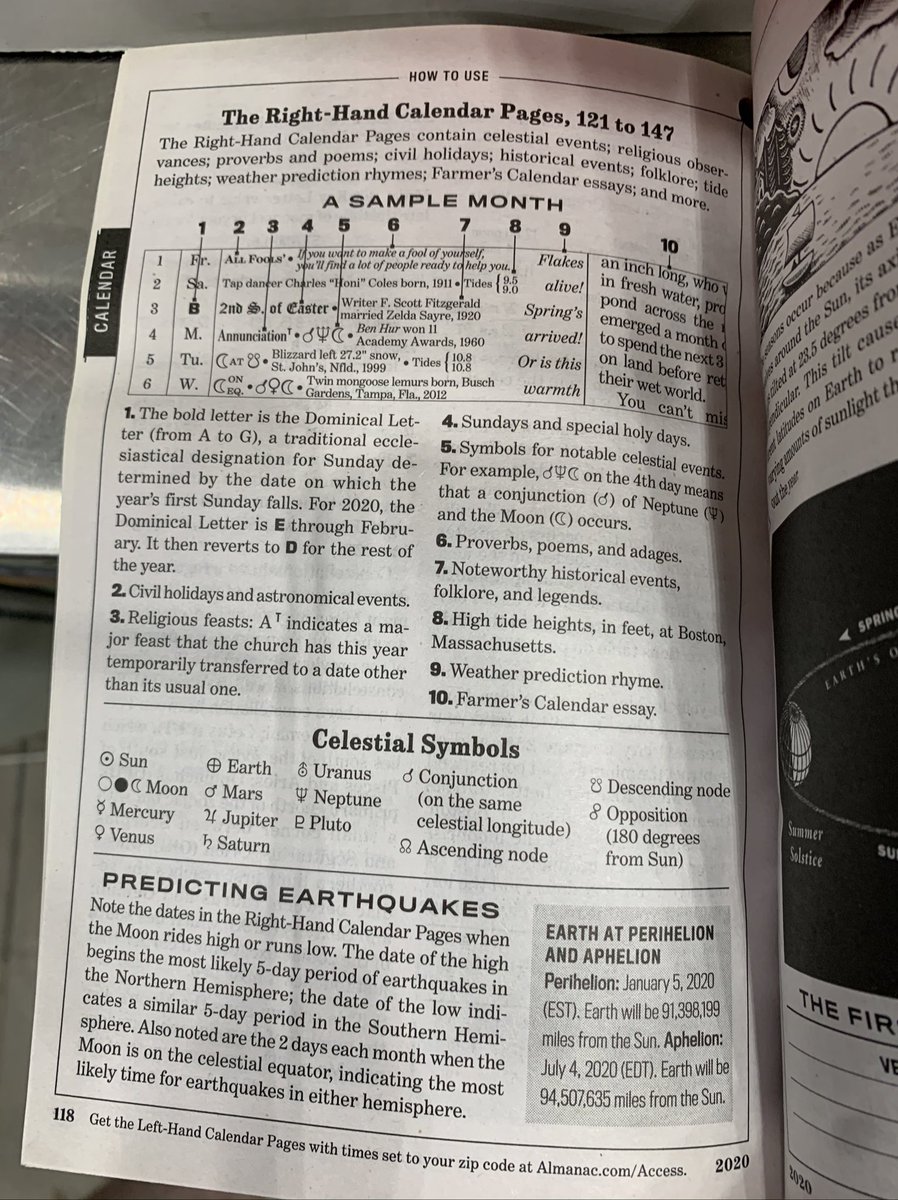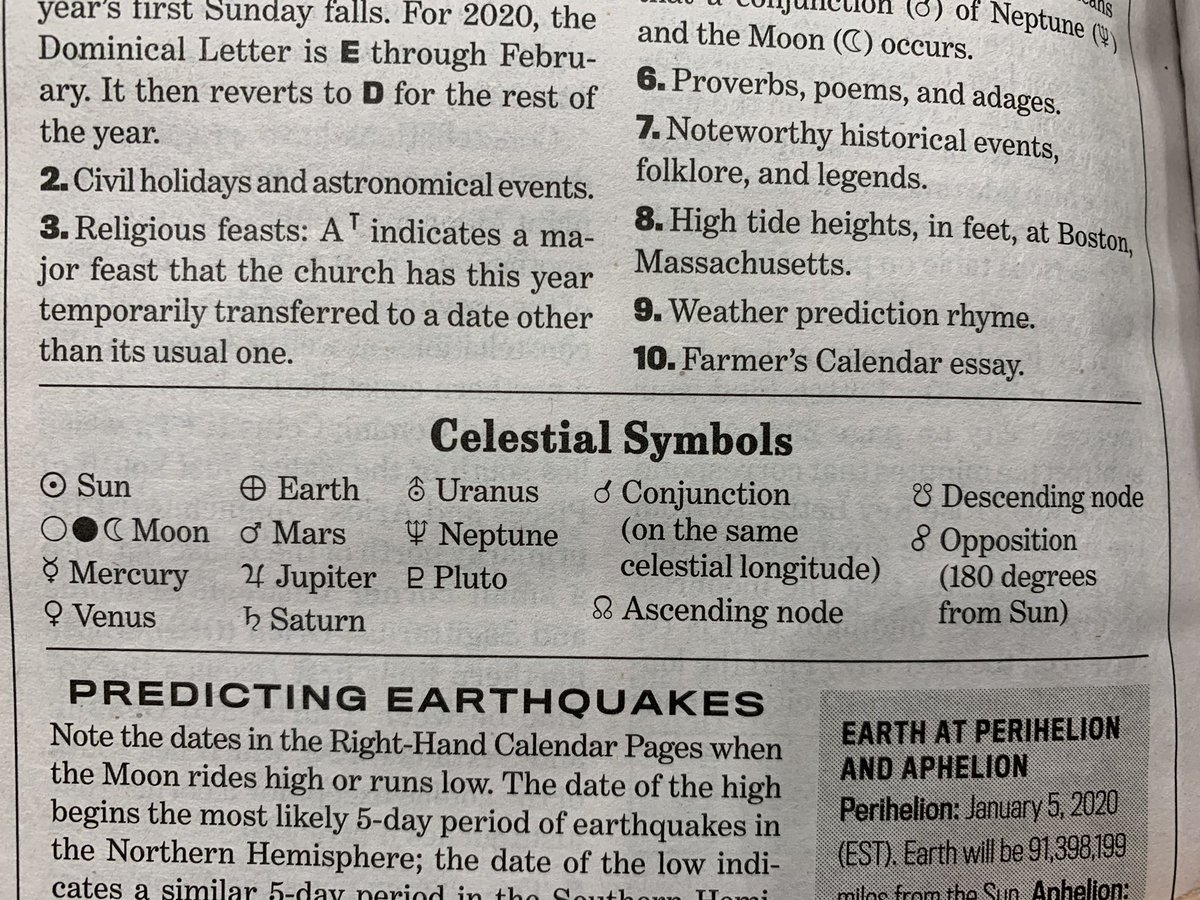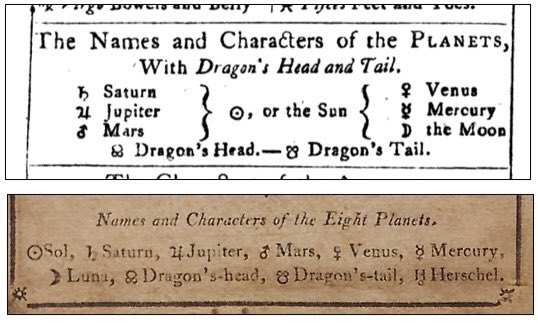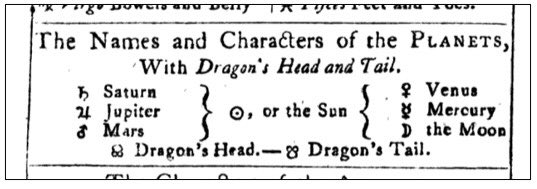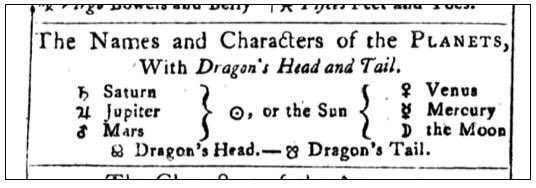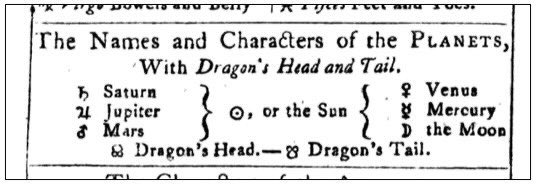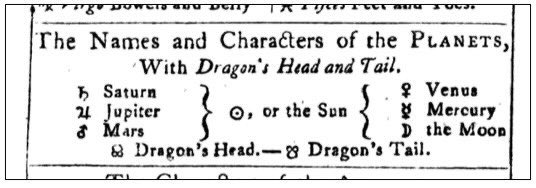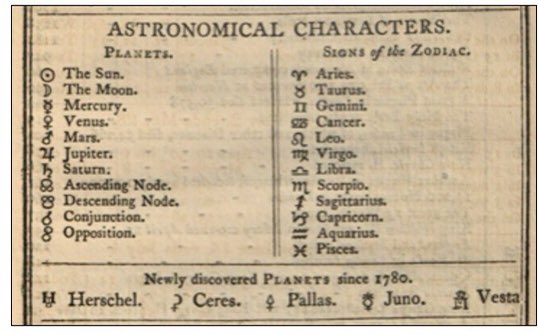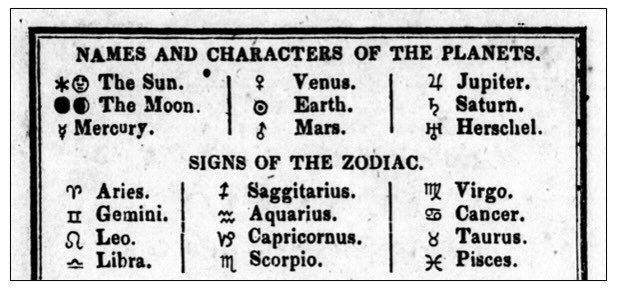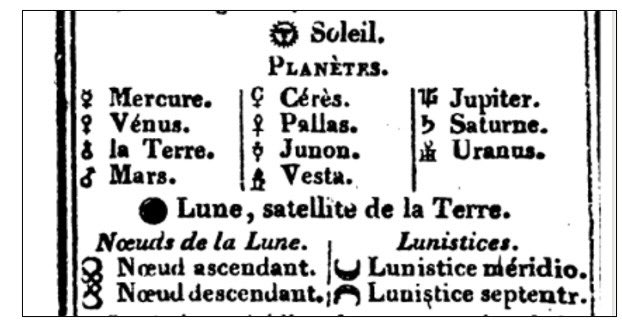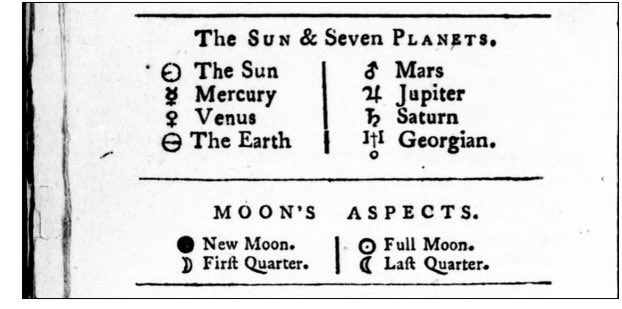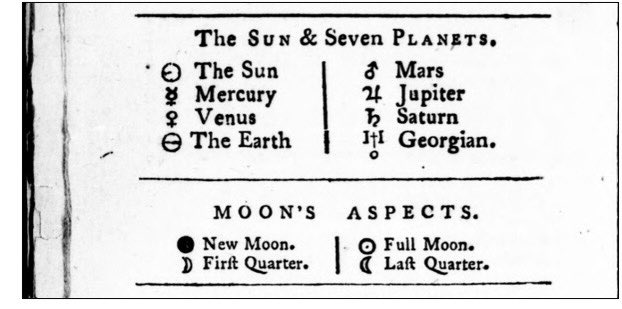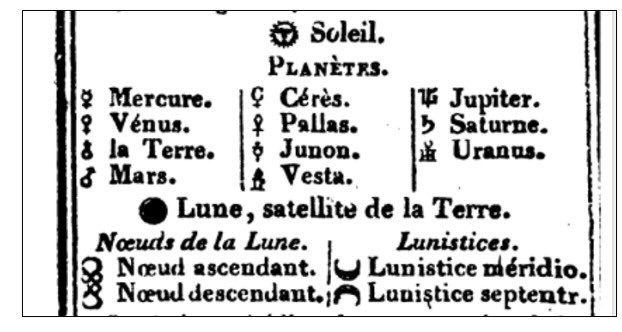I was in Home Depot and saw the Farmer’s Almanac in the checkout line so I snapped this. Almanacs since the 1600s have been publishing lists of planets. It is a fascinating window into culture’s evolving ideas about planets. Astronomy textbooks don’t tell the true story. 1/N
2/ For example, in this 2020 almanac, the list is almost identical those going back to 1800 with only a few changes. 1) It includes Pluto. 2) It avoids calling the objects “planets”. It lumps them together with the lunar nodes and calls them “Celestial Symbols”. I was surprised!
3/ In the early 1800s, the public had *only just* converted to heliocentrism. It took 200 years after Galileo to be convinced. So in 1800 the public’s idea of “planets” was still the “Old Geocentric 7” including the Sun as a planet. Here are lists from almanacs in 1803 & 1806.
4/ Notice how even the shape of the list on the almanac’s page has remained unchanged from 1803 till 2020. These tables are a very long tradition indeed, and we can see all the little changes year-by-year to get insight into the public’s acceptance or rejection of science.
5/ In the 1803 list, they included the Dragon’s head & tail (the places where the Moon’s orbit crosses Earth’s orbit around the Sun) since this is where eclipses occur. In ancient India it was understood to be a long dragon that wraps around the Earth swallowing the Sun or Moon.
6/ Records show that in ancient India there were 9 planets, not 7. This Dragon was the 8th planet, and scholars think a god representing the comets was the 9th. (Apparently they thought the comets were all the same comet returning over and over.) So there were 9 planets. Then...
7/ ...the idea of the Dragon was transmitted through Arabic sources into Europe, but European astrologers did not accept the Dragon as a planet. They kept only 7 planets and named the Dragon (it’s head and tail) as distinct from the planets as you see in the heading of the table.
8/ But note that the Sun was still firmly a planet. In fact, in the 1803 list, it is placed between 2 sets of 3 planets. That is the old Ptolemaic/geocentric ordering of the planets, where the Moon, Venus and Mercury were closest to Earth, THEN the Sun, and THEN the other 3.
9/ This was in the 1800s! By the late 1700s, the Enlightenment had led all the almanacs & most of the public to switch to heliocentrism, but the concept of *planets* was still unchanged. When modern textbooks claim that Copernicus changed our concept of a planet, it is untrue.
10/ Textbooks say, “we discovered the Earth moves and the Sun is the center, therefore the Earth became a planet and the Sun became a non-planet”, but this is untrue. There was no law saying the culture had to base its idea of a planet on whether it moves or not. And they didn’t.
11/ Here are two more examples (of many!) from the cluster of lists that retained the geocentric planet concept into the 1800s. Some of them added Uranus (called “Herschel”). Some added the first 4 asteroids. The latter list is from 1827. Earth is STILL not a planet.
12/ It was a time of chaos. We see three distinct clusters of these lists among the general public, and a distinct fourth list among the scientists. (Yes, the Copernican scientists always included Earth as a planet, but in the 1600s that was only a dozen or so people, total.)
13/ Here are examples from the 2nd cluster of planet lists, 1831 - 1839. These are hybrids. The Earth was added as a planet and the Sun was STILL a planet. Same for the Moon. Adding the Earth was theoretical heliocentrism; keeping the Sun was pragmatic geocentrism for astrology.
14/ So again, the modern textbooks aren’t telling the true story. The public did *not* develop its concept of planets based on Copernican science alone, nor on a simplistic idea that moving objects are planets while “fixed” objects are not. It was more complicated than that.
15/ Another thing to note: They still included the Moon as a planet, but they did NOT include all the other known moons of the solar system as planets. Why not? It is scientifically inconsistent! Several cultural forces were at work, but one of the main causes was *astrology*.
16/ To shorten this thread, if you want to find out about the role of astrology & other cultural forces for omitting the other moons, join the @cosmoquestX hangout at 7 pm ET tonight. We will discuss. But for now, here are examples of the 3rd cluster of planet lists, 1799-1837.
17/ This 3rd cluster looks more like the modern folk concept of a planet (the one the IAU embraced in 2006). They either leave off the Sun & Moon or they avoid calling them planets. This one uses “&c” (“etc”) in the heading to indicate “not everything on this list is a planet.”
18/ This one says “The Sun & Seven Planets” in the heading to make the Sun a non-planet, and puts the Moon in a separate table. (Note that “Georgian.” was an abbreviation for another name of Uranus.)
19/ We also see trends about how many asteroids they added to these lists. Most almanacs stopped after the first 4 asteroids for cultural and astrological reasons, even though scientists considered every asteroid to be a planet until the 1950s/1960s.
20/ I‘ve also traced how “planet” was used in theological writings and sermons, in poetry, in children’s books, in textbooks for lower and higher education, and how scientists conceived of planets. Join us on the @cosmoquest hangout to learn why 1800s culture *rejected* science.
21/ It isn’t surprising when culture resists science, since science was *designed* to rise above everyday human cognition and its culture. But science can lose its way and revert to pre-scientific ideas, like in the 1920s when it abandoned Galileo & accepted the cultural planets.
22/ So nowadays everyone thinks it is natural that planets only include the bodies that orbit the Sun directly, even though moons *are* wanderers (the etymological meaning of “planets”), were *always* planets, & were considered planets by all Copernican scientists till the 1920s.
23/ The reason this 1837 planet list looks like our modern concept of planets, omitting the Sun and all of the moons while including the Earth, is not because there is any logic or scientific basis to it, but because in the mid-1800s culture wars this is the concept that WON.
24/ That culture war was won by the 1880s. One of the three non-scientific concepts of “planet” prevailed. It started appearing in lower education textbooks by 1857 and was nearly universal by 1880. During this entire time, scientists ignored it and kept using Galileo’s concept.
25/ The next super interesting question was WHY did astronomers eventually throw away the reductionist Copernican / Galilean / Keplerian concept of planets and adopt the non-reductionist, astrological/theological concept instead? Publications show it happened shortly after 1920.
26/26 So again, join the @cosmoquestX hangoutathon tonight at 7 pm ET and we will discuss. Also our manuscript with all the details is complete and we will make it available soon. https://cosmoquest.org/x/hangout-a-thon-schedule/">https://cosmoquest.org/x/hangout...

 Read on Twitter
Read on Twitter